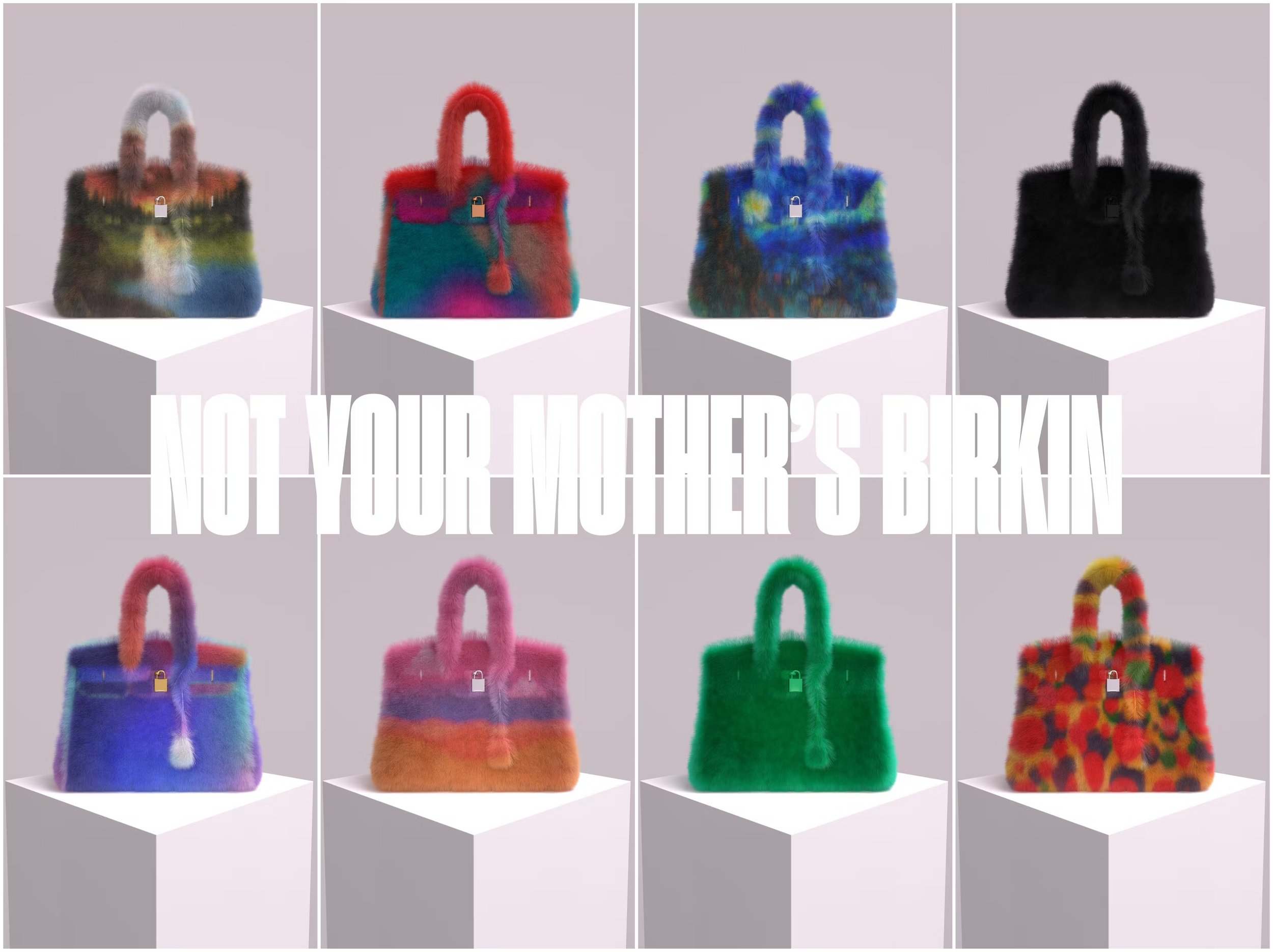The outcome of Hermes' lawsuit against MetaBirkin NFT might show us what the future holds for fashion and art in the metaverse
Hermes recently sued a digital artist for knocking off its Birkin handbag through the issuance of MetaBirkin non-fungible tokens (“NFT”). For those not aware of the filing or related media attention, the artist created fuzzy images of the Hermes Birkin handbag and minted them as NFTs.
NFTs are digital records of data stored on a blockchain and uniquely identifiable. NFTs are associated with a larger digital file that is itself too large to store in a blockchain. The digital record can then be traded or sold as an asset identifying the NFT owner as the true owner of the original digital file.
Using NFTs has, in part, allowed digital artists to associate ownership in an original version of their art through the NFT that can be monetized much like the physical paintings or sculptures of artists creating in physical media.
The artist in the Hermes lawsuit branded his images MetaBirkins and is attempting to sell them on various internet sites using MetaBirkins as a brand name. Hermes is suing the artist for trademark infringement, trademark dilution, and cybersquatting. Hermes based its allegations of trademark infringement and dilution on the artist’s use of MetaBirkin as a trademark to promote his NFTs and at his metabirkin.com website.
Success not guaranteed - what existing legal precedent highlights when art incorporated a trademark
A review of the complaint may lead one to the conclusion that the artist is in line for swift rebuke, but under established trademark law Hermes’ success is not a given.
The Hermes lawsuit raises all sorts of questions for brand owners, artists, and truthfully almost any business owner as to the intellectual property rights in emerging technology, whether it is the metaverse, NFTs, or other expressive mediums that have not yet been conceived.
Fundamentally, the images and related NFTs are expressive works given a large latitude to avoid findings of trademark infringement under the Second Circuit’s test in Rogers v. Grimaldi, 875 F.2d 994 (2d Cir. 1989). Under this line of cases, a two-prong test was developed to assess cases of alleged trademark infringement by artistic works for balancing situations where “public interest in avoiding consumer confusion outweighs the public interest in free expression” that determined use of a trademark in the title of an artistic expression is trademark infringement only if 1) the title has no artistic relevance to the underlying work or 2) explicitly misleads consumers as to source or content of the work. The courts confirmed that only in such cases, the underlying work itself will not be protected under the First Amendment as expressive art.
The First Amendment rights Defence
With this in mind, Rogers is widely thought of as providing for the protection of uses of trademarks in artistic work, to those accused of trademark infringement. In recent times though, there has been a departure away from the Rogers test. In Stouffer v. Nat'l Geographic Partners, LLC, 460 F. Supp. 3d 1133, 1142-43 (D. Colo. 2020), the courts viewed that following Rogers “means that trademarks registered for arguably artistic products and services are not worth the paper that the trademark registration is printed upon. As long as a junior user makes no overt claim to association with the senior user, the junior user can market precisely the same artistic product or service under precisely the same mark.” The court questioned “why this should be permitted in the name of the First Amendment?” Opining that the Rogers test is “needlessly rigid and fails to account for the realities of each situation.”
Rather than focus on the ‘artistic relevance’ of a work. The Court came to the conclusion that the Rogers test, “did not strike the appropriate balance between trademark rights and First Amendment rights,” and devised a new a six-factor ‘genuine artistic motive test’ with additional elements to be considered trademark claims:
Do the senior and junior users use the mark to identify the same kind, or a similar kind, of goods or services?
To what extent has the junior user added his or her own expressive content to the work beyond the mark itself?
Does the timing of the junior user’s use in any way suggest a motive to capitalize on popularity of the senior user’s mark?
In what way is the mark artistically related to the underlying work, service, or product?
Has the junior user made any statement to the public, or engaged in any conduct known to the public, that suggests a non-artistic motive?
Has the junior user made any statement in private, or engaged in any conduct in private, that suggests a non-artistic motive?
The point of these factors is to assist in answering the question, "Did the junior user have a genuine artistic motive for using the senior user's mark or other Lanham Act-protected property right?"
Moreover, even if Rogers does not apply, Hermes’ trademarks are for leather goods, specifically handbags. The NFTs being sold are decidedly not leather goods. Generally, trademarks only apply to the goods or services listed on the registrations and those that are reasonably related to the listed goods or services. Hermes will need to prove its trademark for leather goods extends to expressive images based on the leather goods, which is what the MetaBirkin trademark is selling to consumers.
To succeed on a claim for trademark infringement, the alleged infringer’s conduct must lead to a likelihood of consumer confusion. Whether Hermes can demonstrate that consumers will confuse Hermes and its handbags with digital images of altered handbags using MetaBirkin is an open question — and it will be interesting to see how the court resolves the issue.
According to Mason Rothschild, creator of the MetaBirkin NFT and defendant named in the Hermes complaint, he is exercising his First Amendment rights — just as Andy Warhol did when he created his famous Campbell’s Soup Cans in the early 1960s.
What does all this NFT discussion mean for a business owner?
First, if your business has an interest in joining the NFT marketplace, it would be wise to update any trademarks currently used to include NFTs as a good. This can be done by filing an intent-to-use application if you are not ready to immediately enter the digital realm.
Second, be on the lookout for competitors and opportunists knocking off your design patents, goods, and services, or causing consumer confusion.
Third, be careful in creating NFTs. Copyright and right of publicity rules apply to the use of third-party works. As noted in the Hermes lawsuit, trademark rules may apply depending on the circumstances. Design patents can also apply depending on the goods and circumstances.
IP rights in flux
Finally, properly protecting your NFTs requires contracts with specific terms as to minting, royalty rights, and intellectual property ownership. Ownership fights over who owns the NFT and/or the underlying work are only going to increase soon as Miramax’s fight with Quentin Tarantino over “Pulp Fiction” NFTs demonstrates.
NFTs allow brands the ability to directly connect with consumers using new technology. Consumers and brands can interact with each other in brand-specific environments through the decentralized metaverse. Artists and creators can monetize ownership of their digital creations.
This emerging technology is a powerful tool that if used properly can strengthen the ties between brands/artists and consumers. However, the technology and the decentralized nature behind NFTs have placed the extent and scope of existing intellectual property rights in flux. Before venturing into this new world, it is best to fully understand what you are stepping into, so you don’t become lost in the void.
Written by Joseph Barber, a partner at Howard & Howard Attorneys with additional edits from Tania Phipps-Rufus, Founder and Editor at FLB.

